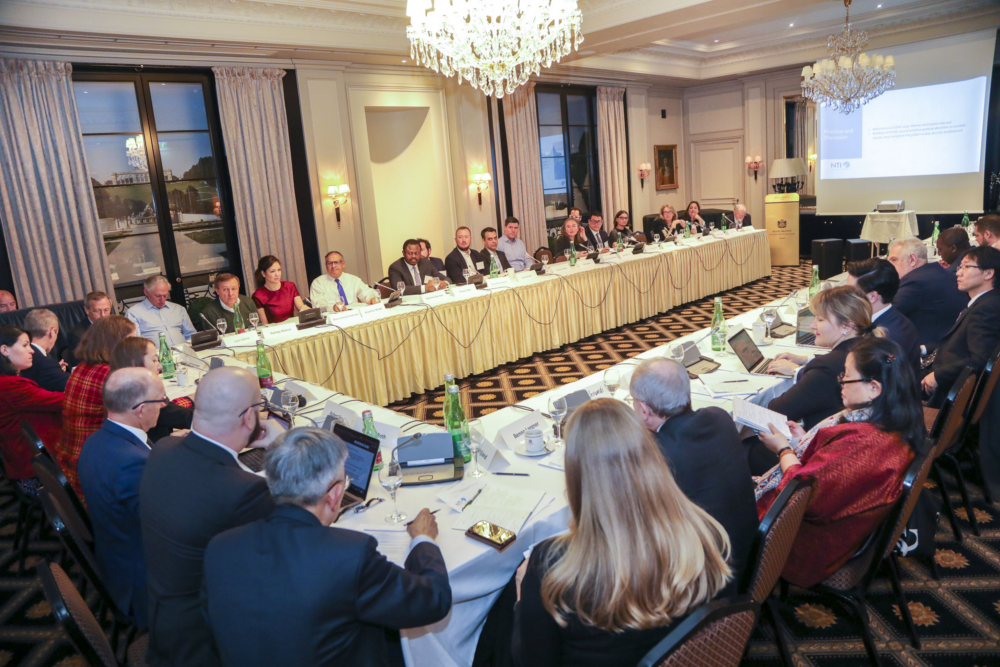Diplomacy can take many forms. Conversations that were once limited to official meetings between government representatives now happen in multiple forums. Later this month, for example, NTI | bio will host a series of meetings related to the annual Global Biosecurity Dialogue. In June, NTI’s Global Nuclear Policy Program will convene a regional workshop related to the Global Enterprise to Strengthen Nonproliferation and Disarmament. In the policy realm, meetings that include members other than current government officials are termed Track 1.5 and Track 2 dialogues.
What are these tracks, and why are they important? How do they relate to Track 1 diplomacy—direct dialogue between official country representatives?
Definitions
- Track 1 Diplomacy refers to official diplomacy, where communication is directly between or among governments. These formal discussions are conducted by diplomats, heads of state, and other official authorities. Most negotiations held at international organizations like the United Nations and the Organization for Security and Cooperation in Europe fall under this category, as do bilateral negotiations between two countries.
- Track 1.5 Diplomacy occurs when government representatives and non-governmental experts engage in dialogue or meetings together in less formal ways than Track 1 diplomacy. For example, the China-U.S. Strategic Nuclear Dynamics Dialogue, run by the Center for Strategic and International Studies, a nonprofit policy research organization, and later the Pacific Forum from 2004 until 2019, provided an avenue for what officials often describe as “frank and candid” discussions with Chinese counterparts on nuclear issues. By bringing together think tank experts, retired officials, and active government and military officials, the dialogue led to a unique series of conversations where both sides could exchange views and build trust, even in the face of broader tensions.
- Track 2 Diplomacy denotes a purely unofficial channel for dialogue between non-governmental experts, without direct governmental involvement. The 1993 Oslo Accords between representatives of Israel and the Palestine Liberation Organization, for instance, grew out of unofficial Track 2 discussions before transitioning into Track 1 negotiations.
Why do different routes exist?
Multi-track diplomacy is an increasingly important element of dialogue to address global challenges. Although Track 1.5 and Track 2 discussions are unofficial and do not hold the same authority as official negotiations between government representatives, they often allow for different perspectives to be shared by opening discussions to civil society actors and organizations. This, in turn, can help broaden the scope of a conversation, facilitate more open and frank communication, provide more in-depth understanding of policy challenges and offer a forum to explore new ideas that potentially can be fed into Track 1 dialogues. Moreover, unofficial dialogues can provide a venue for engagement when official ties are dormant, fraught, or hard to navigate.
While the terminology and the idea of “tracks” dates back about 40 years, there has been a long history of informal dialogue supporting official discussions and processes. For instance, in 1967, U.S. and Soviet officials made progress towards negotiation of the Nuclear Non-Proliferation Treaty (NPT) during a hike near Lake Geneva, an important testament to the progress possible beyond official meetings.
Recent years have seen an expansion of Track 1.5 and Track 2 diplomacy. This can be traced in part to a changing geopolitical climate, a more interconnected world, and the growth of nongovernmental organizations poised to engage in such efforts. At a time of great-power rivalries and diverse global security challenges, informal discussion can facilitate steps forward when diplomatic channels are an ineffective or nonexistent option or when they are working but would benefit from fresh ideas.
The world of international affairs also is changing. The United States now has over 2,200 think tanks, more than double the number it had in 1980, and there has been a similar surge of organizations in the non-profit sector globally. As the scope and magnitude of outside policy voices has increased, so has the influence of those outside perspectives, coinciding with the rise of multitrack diplomacy.
NTI Dialogues
NTI regularly contributes to and hosts both Track 1.5 and Track 2 diplomatic dialogues aimed at reducing global nuclear and biological risks.
What do NTI’s Track 1.5 and Track 2 dialogues look like in practice?
- Global Dialogue on Nuclear Security Priorities, Track 1.5, Nuclear Materials Security Program – This high-level, international dialogue was designed to strengthen and build upon the global nuclear security system. Through the Global Dialogue, NTI convenes high-level government officials from the United States and other countries, as well as nongovernmental experts, nuclear security practitioners, and other stakeholders, to discuss methods to secure the nuclear materials that currently are stored in 22 countries. In addition to national governments, the dialogue, initiated in 2014, has included international organizations such as the International Atomic Energy Agency, INTERPOL, the European Union, and the United Nations, as well as industry stakeholders. It has engendered ideas for a sustainable approach to nuclear materials security, many of which were adopted during a series of biennial Nuclear Security Summits that brought together heads of state from more than 50 countries and international organizations from 2010-2016.
- Global Enterprise to Strengthen Nonproliferation and Disarmament (GE), Track 1.5, Global Nuclear Policy Program (GNPP) – Launched in 2018, the Global Enterprise is a multi-year initiative devoted to strengthening the NPT regime. By convening officials from more than 20 countries along with non-government experts, GE meetings allow participants to discuss ideas and find shared perspectives that will advance NPT goals at a time when the international community has become increasingly divided on the role of nuclear deterrence. These meetings have contributed to an increased focus on nuclear risk reduction as part of official discussions of NPT priorities.
- Global Biosecurity Dialogue, Track 1.5, Global Biological Policy Programs – The Biosecurity Dialogue addresses the under-representation of biosecurity as a policy, technical, and financial priority on the international stage. By allowing senior officials from across sectors and disciplines to join together in conversation, the initiative has created concrete steps for countries to fill biosecurity capability gaps; strengthen national, regional, and international biosecurity policy frameworks; and address emerging risks effectively.
- U.S.-Russia Cyber-Nuclear Weapons Dialogue, Track 2, Science and Technical Affairs Program and GNPP– The Cyber-Nuclear Weapons Dialogue was created following the release of NTI’s 2018 report on Nuclear Weapons in the New Cyber Age. To increase understanding and explore ways to mitigate cyber-nuclear threats, the dialogue over the past few years has brought together U.S. and Russian nuclear policy and cybersecurity experts. The project aims to generate recommendations for risk reduction and potential cooperative efforts that could mitigate cyber risks to American and Russian nuclear weapons and related systems.
As the policy world continues to confront new and evolving challenges, diplomatic approaches will shift and expand as well. Informal dialogues and unofficial relationships are increasingly important, providing additional routes to engage and develop solutions to global concerns. In the face of long-standing and persistent geopolitical tensions, including those between the United States and China and the United States and Russia, unofficial diplomacy can offer opportunities for dialogue and problem-solving, even when official diplomatic ties are strained or broken.

